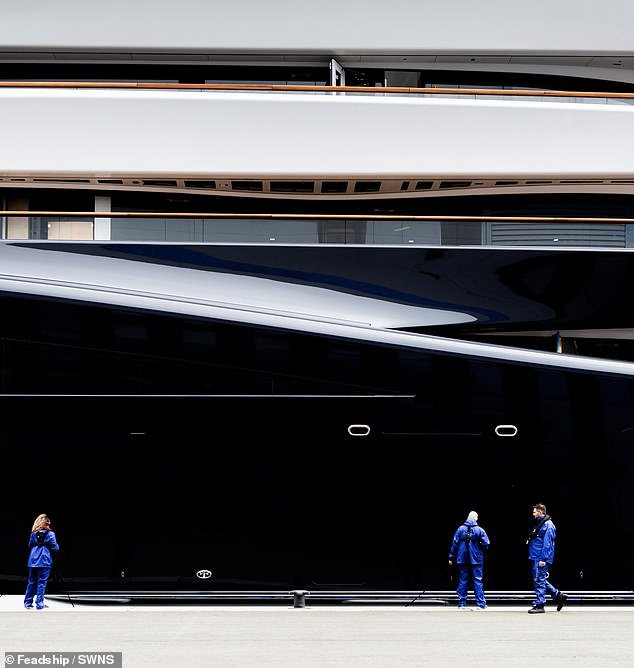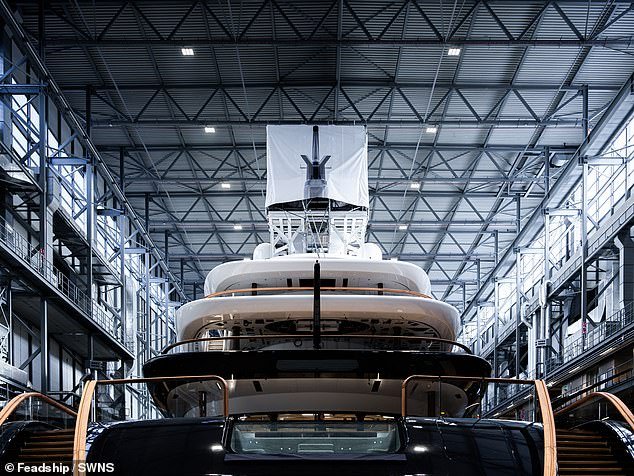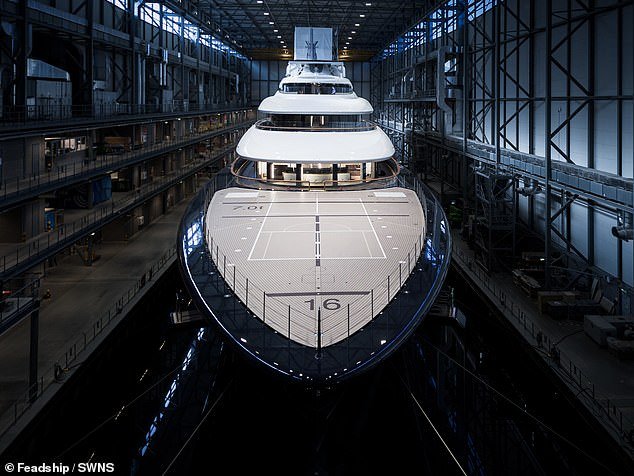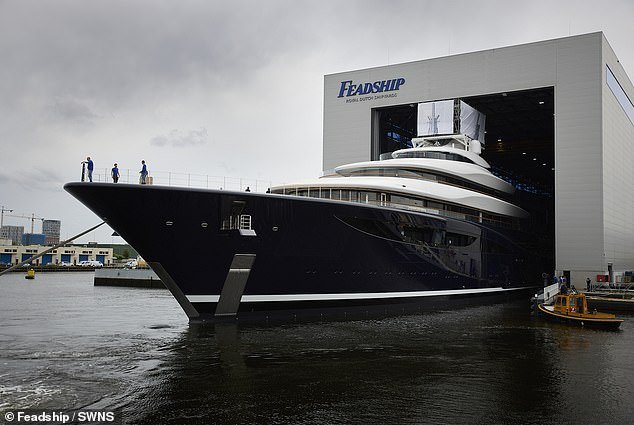The world’s first hydrogen superyacht linked to Bill Gates is hitting the high seas – and the 120-metre boat with two bedrooms, a gym and offices is for sale for more than $600 million
The world’s first hydrogen gas superyacht, long rumored to have been commissioned by billionaire Microsoft founder Bill Gates, is now officially for sale.
The 119-meter-long superyacht, called Project 821, is designed to sail on ‘green’ hydrogen. To be stored as a liquid, the gas must be cryogenically stored at -423.4 degrees Fahrenheit in a carefully designed, double-walled enclosure. tanks.
Dutch shipbuilder Feadship said the May 4 launch of the approximately $646 million vessel at its Amsterdam shipyard sees the yachting world “forever changed.”
The apparently eco-friendly superyacht took more than five years to build, from design to completion, with custom additions yet to be made for the eventual buyer.
While a flurry of news reports leaked in 2020 that Feadship and design firm Sinot Yacht Architecture & Design had been commissioned by the billionaire to build this hydrogen-powered eco-yacht, details verifying the Gates deal remained elusive.
As a yacht industry trade magazine deliberately put it at the time: ‘Although Sinot has denied that Gates is building the concept, Gates is believed to be in talks to build a new superyacht with an unknown yard.’
The world’s first hydrogen gas fuel cell superyacht (pictured), long rumored to have been commissioned by billionaire Microsoft founder Bill Gates, is now officially on sale

Called ‘Project 821’, the 119-metre superyacht (above) is designed to run on ‘green’ hydrogen gas – although to be stored as a liquid, this gas must be cryogenically stored at an incredible -423.4 degrees Fahrenheit in carefully designed, double-walled tanks
That trade publication, BOAT Internationalpublished a statement from Sinot denying any official agreement with Gates for the luxury boat project.
Responding to reports in the Guardian and the Sunday Telegraph, Sinot said: ‘Several articles have appeared in the international media stating that Sinot Yacht Architecture & Design has sold its Aqua concept to Mr Bill Gates.’
“These articles are factually incorrect.”

Although there were denials, the trade press stated in 2020 that ‘it is clear that Gates is in talks to build a new superyacht’
However, Feadship only declined to comment fully, tellingly Mega yacht news that it ‘does not comment on its order book.’
And this month, news broke on financial news site Benzinga that Gates was planning to sell his ownership of an undisclosed superyacht, as well as his $25 million yacht, the Wayfinder: a 70-meter catamaran-style boat built by the famous shipbuilder Astilleros Armon.
The Wayfinder, according to Benzingawas “designed as a shadow ship, typically accompanying a larger mother ship, which was not revealed until recently.”
The site, which features stock trades and other business news, indicated that this mothership was in fact Feadship’s new hydrogen superyacht, Project 821.
Unlike traditional yachts that rely on diesel engines or other fossil fuel propulsion means, hydrogen fuel cell yachts use hydrogen as their primary fuel source.

Unlike traditional yachts that rely on diesel engines or other fossil fuel propulsion means, hydrogen fuel cell yachts use hydrogen as their primary fuel source. Above, a rear view of the upper decks of the new hydrogen superyacht

Hydrogen gas (H2) reacts with oxygen gas (O2) in a fuel cell, creating nothing but pure electricity and pure water: H2O. Above is a ‘foredeck’ or front view of the new superyacht
Hydrogen gas (H2) reacts with oxygen gas (O2) in the fuel cell, creating nothing but pure electricity and pure water: H2O.
“The goal was to develop a new, clean technology, not only for this project, but for the whole world,” says Jan-Bart Verkuyl, director and CEO of Feadship.
The company added that the size of the yacht made it a good candidate for exploring the feasibility of a pure green hydrogen fuel cell system.
The ship’s liquid hydrogen fuel requires approximately 8 to 10 times more storage space than traditional diesel fuel for an equivalent amount of energy. Feadship said.
All that fuel tank space, in addition to the 16 fuel cell energy converters themselves, plus the necessary switchboard connection for the DC mains and a set of water vapor emission vent stacks, added 4 meters to the ship’s original specifications.
“For those fascinated by groundbreaking innovations,” Feadship said in a statement, “this yacht presents an opportunity for potential purchase as it showcases the pinnacle of modern technological advancements.”
The company presented the expensive luxury ship as an investment in the future of sustainable technology, as a glamorous R&D project.

This month, news broke on financial site Benzinga that Gates was planning to sell his ownership of an undisclosed superyacht, as well as his $25 million yacht, the Wayfinder – a smaller 224-foot catamaran boat ‘designed as a shade ship, which usually accompanies a larger mothership’. ‘

The gigantic Project 821 has five decks above the waterline and two below sea level, 14 balconies, seven folding platforms, a swimming pool, a Jacuzzi, a steam room, two bedrooms, two bathrooms, a home gym, utility room, two offices each with fireplace and space for your own library
“Investment in the necessary technology is necessary to transition away from fossil fuels,” says Feadship, “and hydrogen is one of the most efficient and cleanest options.”
But beyond the environmentally conscious amenities, Project 821 also serves its elite market of wealthy seafarers with a variety of ‘superyacht’ requirements.
The ship has five decks above the waterline and two below sea level.
It has 14 balconies, seven folding platforms, a swimming pool, a Jacuzzi, a steam room, two bedrooms, two bathrooms, a home gym, utility room and two offices each with a fireplace.
The ship also has space for the owner to store a full library.
According to Feadship, the boat’s power and food supplies enable “all-week silent operation at anchor or (brief) emission-free navigation at 10 knots while leaving ports or sailing in marine protected zones.”
“It essentially creates a secluded four-story seaside mansion,” the company boasted in their press release, “within the much larger yacht.”
Britain’s RWD Studio, rather than Sinot, was reportedly responsible for crafting Project 821’s exterior and interior furnishings, which employed marble, rattan, taupe-eucalyptus and limed oak to create, in Feadship’s words, “a luxurious coastal atmosphere.
When reached for comment this year, a Feadship spokesperson reiterated that it would not be revealed who originally commissioned the eco-superyacht, nor who would ultimately purchase the vessel.
“Feadship does not share information about owners and prices,” the company said, “whether it is a 19-meter yacht from the 1960s or a 119-meter yacht from the 21st century.”
